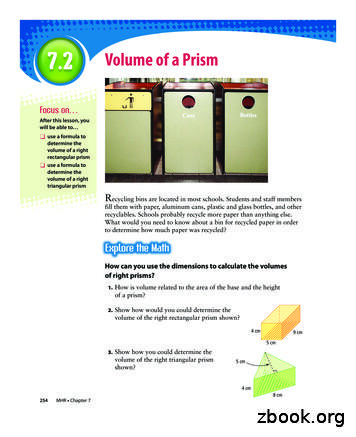Deflections And Rotations In Rectangular Beams With .
Smart Structures and Systems, Vol. 22, No. 6 (2018) 689-697DOI: ctions and rotations in rectangular beams with straight haunches underuniformly distributed load considering the shear deformationsJosé Daniel Barquero-Cabrero1,2a, Arnulfo Luévanos-Rojas 1, Sandra López-Chavarría1b,Manuel Medina-Elizondo1c, Francisco Velázquez-Santillán1d and Ricardo Sandoval-Rivas1e1Institute of Multidisciplinary Researches, Autonomous University of Coahuila,Blvd. Revolución No, 151 Ote, CP 27000, Torreón, Coahuila, México2Institute for Long Life Learning IL3, University of Barcelona, Street Girona No, 24, CP 08010, Barcelona, Spain(Received October 7, 2018, Revised November 22, 2018, Accepted November 24, 2018)This paper presents a model of the elastic curve for rectangular beams with straight haunches under uniformlydistributed load and moments in the ends considering the bending and shear deformations (Timoshenko Theory) to obtain thedeflections and rotations on the beam, which is the main part of this research. The traditional model of the elastic curve forrectangular beams under uniformly distributed load considers only the bending deformations (Euler-Bernoulli Theory). Also, acomparison is made between the proposed and traditional model of simply supported beams with respect to the rotations in twosupports and the maximum deflection of the beam. Also, another comparison is made for beams fixed at both ends with respectto the moments and reactions in the support A, and the maximum deflection of the beam. Results show that the proposed modelis greater for simply supported beams in the maximum deflection and the traditional model is greater for beams fixed at bothends in the maximum deflection. Then, the proposed model is more appropriate and safe with respect the traditional model forstructural analysis, because the shear forces and bending moments are present in any type of structure and the bending and sheardeformations appear.Abstract.elastic curve; rectangular beams; straight haunches; uniformly distributed load; moments in the ends;bending and shear deformations; Timoshenko Theory; Euler-Bernoulli Theory; deflections and rotations on the beamKeywords:1. IntroductionDeformation of reinforced concrete beams and steelbeams is an important measure of their serviceabilityperformance, already is specifically required in the currentperformance-based design codes. Generally, deformationsof beams consist in the bending and shear deformations.In structural engineering, there are two design criteriafor the beams: the strength and the serviceability.The problem of the elastic curve to obtain thedeflections and rotations anywhere for the non-prismaticbeams subjected to any type of load and to differentboundary conditions has been investigated by manyresearchers. Corresponding author, Ph.D.E-mail: arnulfol 2007@hotmail.comPh.D.E-mail: jd.barquero@eserp.combPh.D.E-mail: sandylopez5@hotmail.comcPh.D.E-mail: drmanuelmediana@yahoo.com.mxdPh.D. StudentE-mail: frankv2010@hotmail.comePh.D. StudentE-mail: ricardo sandoval rivas@hotmail.comaCopyright 2018 Techno-Press, ge 7The relevant publications of non-prismatic cantileverbeams are those of Lee (2002), Dado and Al-Sadder (2005),Borboni and De Santis (2006), Banerjee et al. (2008),Solano-Carrillo (2009), Chen (2010), Yau (2010), Brojan etal. (2012).Yuksel (2009) studied the behaviour of symmetricallyhaunched non-prismatic members subjected to temperaturechanges. Yuksel (2012) investigated the non-prismaticbeams having symmetrical parabolic haunches withconstant haunch length ratio of 0.5. Ponnada and Vipparthy(2013) used the improved method of estimating deflectionin prestressed steel I-beams. Luévanos-Rojas (2014)presented a mathematical model of the elastic curve forsimply supported beams subjected to a uniformlydistributed load taking into account the shear deformationsfor a prismatic section. Ponnada and Thonangi (2015)showed the deflections in non-prismatic simply supportedprestressed concrete beams. Bouchafa et al. (2015)analyzed the thermal stresses and deflections of functionallygraded sandwich plates using a new refined hyperbolicshear deformation theory. Razavi et al. (2015) presented theload-deflection analysis prediction of CFRP strengthenedRC slab using RNN. Akbas (2015) analyzed thelarge deflection of edge cracked simple supported beams.Luévanos-Rojas et al. (2016a) investigated a mathematicalmodel of the elastic curve for simply supported beamssubjected to a concentrated load taking into account theshear deformations for a prismatic section. Li and Chen(2016) showed the deflection of battened beams with shearISSN: 1738-1584 (Print), 1738-1991 (Online)
690José Daniel Barquero-Cabrero et al.and discrete effects. Unsal et al. (2017) presented a study onload-deflection behavior of two-span continuous concretebeams reinforced with GFRP and steel bars. Ju et al. (2017)studied the flexural behaviour and a modified predictionof deflection of concrete beam reinforced with ribbed GFRPbars.There are some papers that show methods of structuralanalysis for statically indeterminate beams and frames forprismatic sections taking into account the bending and sheardeformations (Luévanos-Rojas 2012, 2013a, b).Also, there are papers that present the fixed-endmoments of a beam subjected to a uniformly or triangularlydistributed load taking into account bending and sheardeformations for prismatic sections (Luévanos-Rojas 2013c,d).The papers that describe the modeling for beams crosssection “I” or “rectangular” subjected to a uniformlydistributed load or concentrated load with straight haunchestaking into account the bending and shear deformationsshow the fixed-end moments, carry-over factors andstiffness factors (Luévanos-Rojas 2015, Luévanos-Rojas etal. 2016b, c, Luévanos-Soto and Luévanos-Rojas 2017).The literature reviews of researches developed and/orcompared by software are shown below:Majumder and Kumar (2013) analyzed the maximumdeflection of a simply supported beam under different typesof loading. The loads are: a) Concentrated load at the midspan; b) uniformly distributed load; c) Triangularlydistributed load. The theoretical analysis was realized bythe Euler-Bernoulli Theory, and compared with the ANSYS14.0 software. On comparing the numerical results to thoseobtained from the commercial software ANSYS 14.0,excellent accuracy of the present method has beendemonstrated. Moreover while using ANSYS it has alsobeen noted that in case of deflection the Element 2 i.e., TET8 Node element gives a closer value in all types of loadingthan the Element 1 i.e. BRICK 8 Node element. Thisinference is exactly opposite in case of stress analysis.There ELEMENT 1 gives a better result than ELEMENT 2.Hence it can be concluded that when the deflection of asolid structure is to be ascertained the user can use, in caseother preferences are absent, 8 Node TET Element. Butwhen stress analysis is essential 8 Node BRICK elementshould be preferred. Note: If results were most accuratebetween the Euler-Bernoulli Theory and the ANSYS 14.0software as shown in the conclusions, then the sheardeformations are not considered in the ANSYS 14.0software.Debnath and Debnath (2014) studied the maximumdeflection for different uniform rectangular cross sectionbeams, and beams types are: a) Simply supported beamwith a uniformly distributed load; b) Simply supportedbeam with a concentrated load at center; c) Cantilever beamwith a uniformly distributed load; d) Cantilever beam with aconcentrated load at the end. The theoretical calculationwas made according to the Euler-Bernoulli Theory, and thecomputational analysis was realized by the ANSYS 14.0software. The data considered for all beams are: L 100 m,b 10 m, h 10 m, ν 0.3, E 2 10 7 N/m2, F 500 N.The studied solid elements were 188, 189, 185, and 285.The most accurate result was measured by solid 189
rotations in two supports and the maximum deflection of the beam, another comparison is made for beams fixed at both ends with respect to the moments and reactions in the support A, and the maximum deflection of the beam to observe the differences of the two models. 2. Method
Figure 3-19 Maximum Allowable Deflections Some Intended Pedestrian Use Figure 3-20 Maximum Allowable Deflections Heavy Intended Pedestrian Figure 3-21 Maximum Allowable Deflections Heavy Intended Pedestrian Figure 3-22 Optimized Service I Deflections vs. Span Length Simple Spans Figure 3-23 Optimized Service I Deflection vs. Span Length Continuous
rotations are performed. Indeed, Eq. (1) is a linear transformation that can be represented by a matrix, and matrices in general do not commute. However, for small rotations at linear order in δχthe result does not depend on the order of rotations. As an example consider two successive rotations r(1) r h δχ(1) r i, r(2) r(1) h .
Catalogue - 06 GALVANIZED PIPE & FITTINGS GALVANIZED DUT 4' SE TION MODEL DESCRIPTION PRICE GV1214 8" x 8" Rectangular Duct 30GA 21.64 GV1215 8" x 10" Rectangular Duct 30GA 22.47 GV1216 8" x 12" Rectangular Duct 30GA 23.31 GV1217 8" x 14" Rectangular Duct 30GA 24.14 GV1218 8" x 16" Rectangular Duct 30GA 24.97
Solution a) Volume of a right rectangular prism area of rectangular base height of prism Volume of a right rectangular prism (length width) height V l w h V 2 3 4 V 24 The volume of the right rectangular prism is 24 cm3. b) A cube is also a right rectangular prism. Volume o
focus on the optical observational data, and we study the statistical properties of the detected EVPA rotations in both observing sea-sons. We aim to determine the average parameters of the rotations, and test possible correlations between these parameters as well as the average total flux density and fractional polarization. The in-
Synchronization of rotations is the problem of estimating rotation matrices R 1;:::;R N from noisy measurements of relative rotations R i R j. The set of available measurements gives rise to a graph structure, where the Nnodes correspond to the rotations R i and an edge is present between two
Using Rotations to Obtain Compatibility Equations for Statically Indeterminate Trusses Harry E. Williams1 and Clive L. Dym, P.E., F.ASCE2 Abstract: This paper presents a new way of determining the compatibility conditions for statically indeterminate trusses. It is based on equations relating the angular displacements (rotations) of truss elements to the corresponding extensions obtained by .
Beginning Reader Stories Level 01 Author: Clark Ness Created Date: 6/9/2015 3:03:34 AM .























